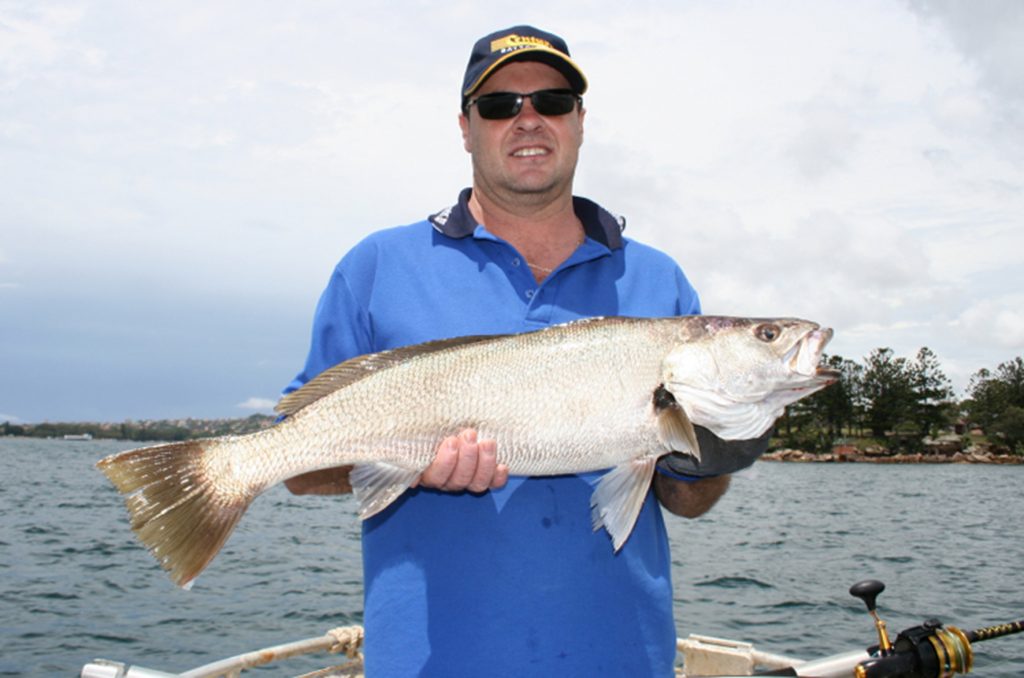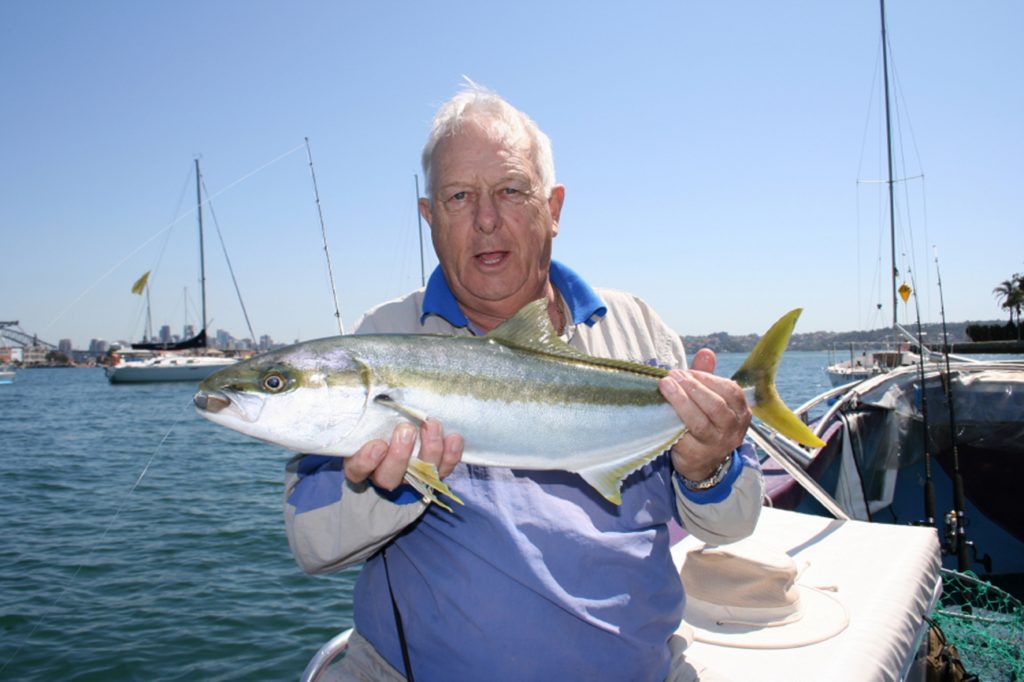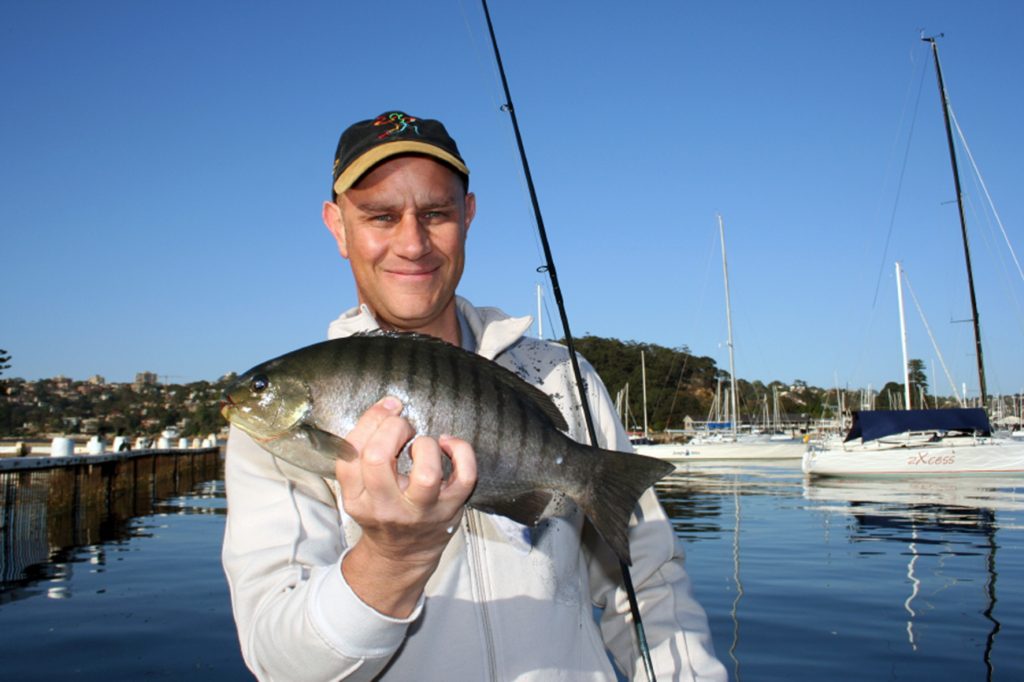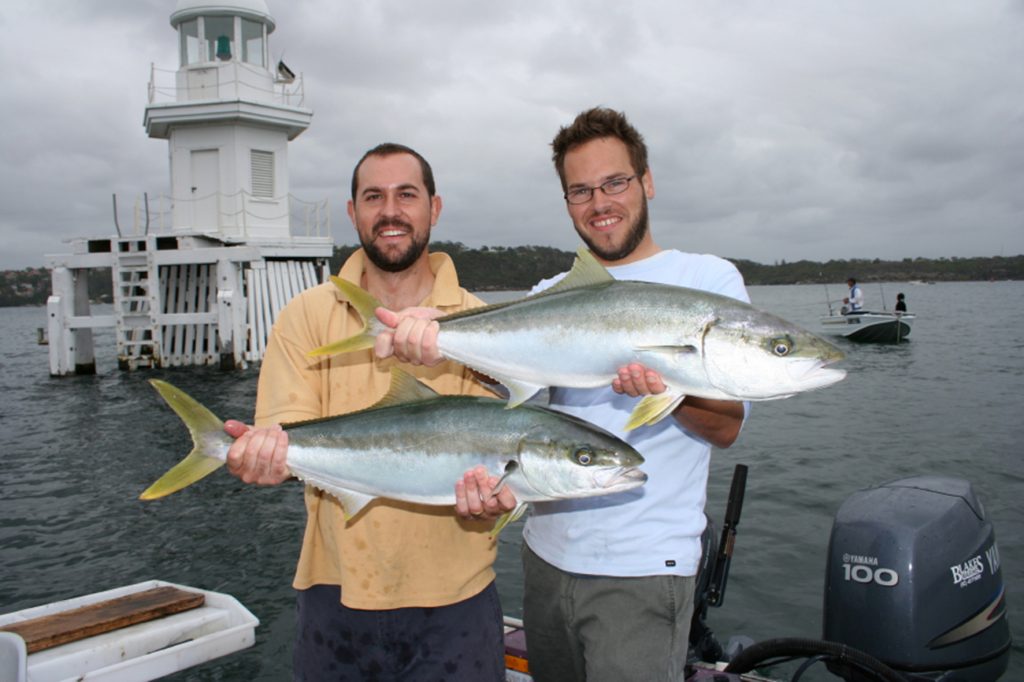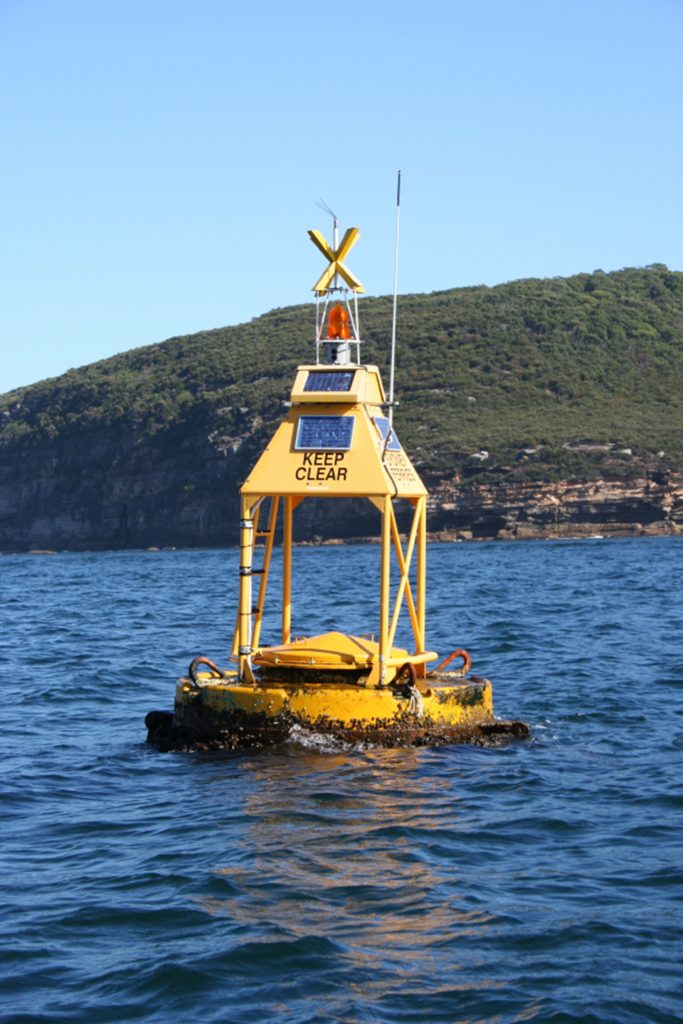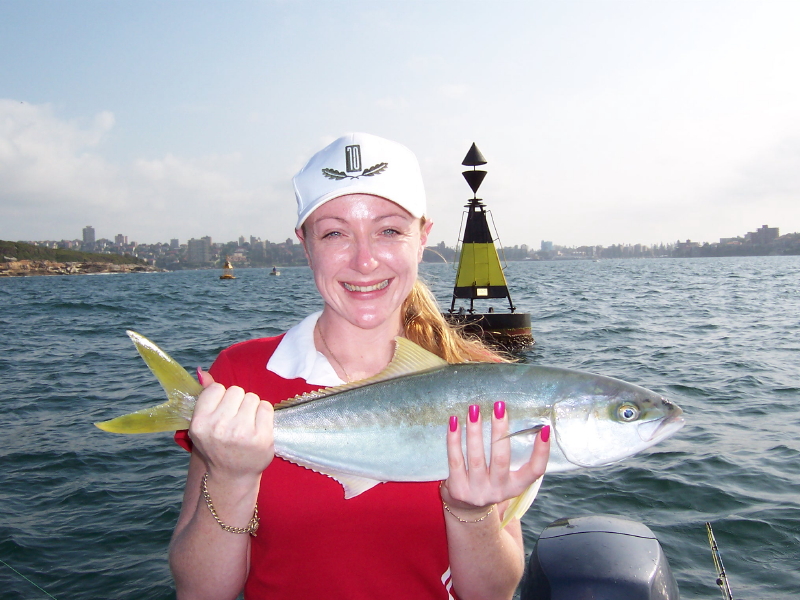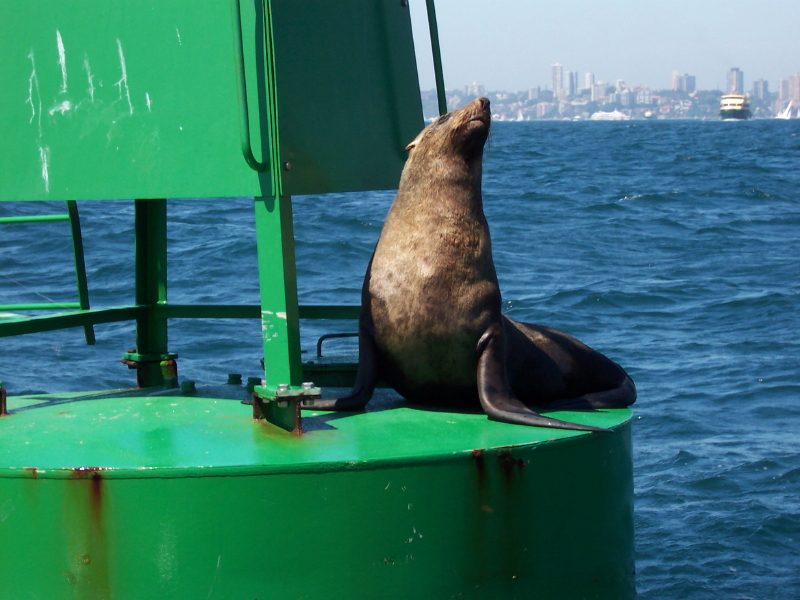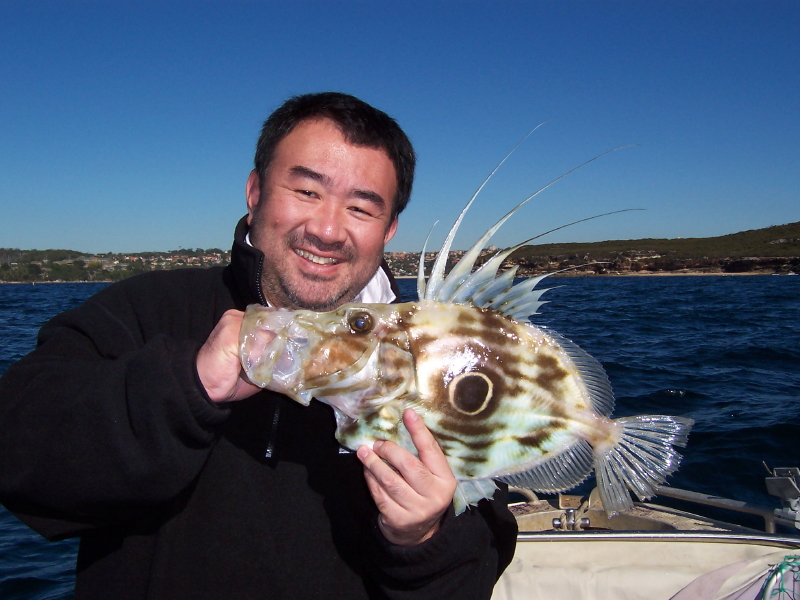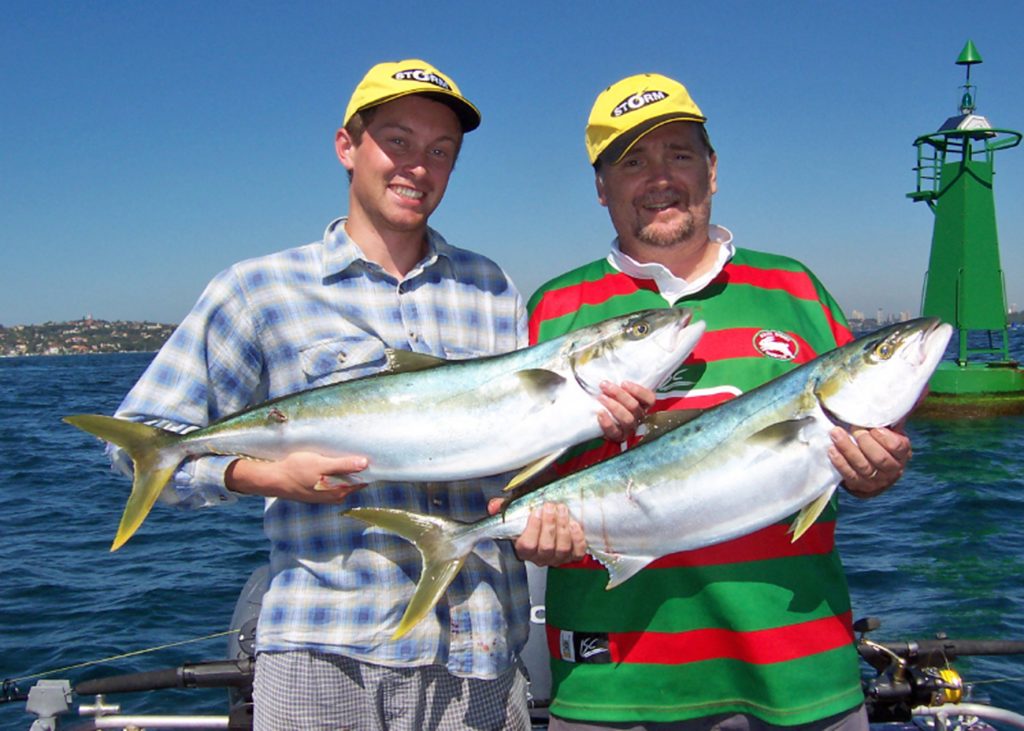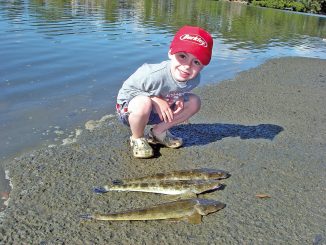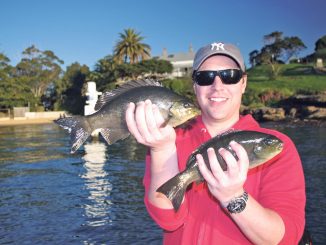
by Craig McGill •
Structure, either artificial or natural, means different things to different fish.
For some, like leatherjackets and luderick, it’s a food source in the form of barnacles, weed, crustaceans and all the other critters that live on the structure itself.
And predatory fish on the move, the likes of bonito and salmon, could find a marker buoy a convenient and reliable feed stop for the baitfish that hang around, even if these predators do not find the structure itself attractive. You will catch bonito, tailor and salmon around a buoy but they rarely stay long.
Kings, on the other hand, use a buoy to hunt food, as a reference point, for shade while they have a rest or all of the above. They hang around structure even if it has no food supply and use it as a ‘base’ from which to mount hunting trips to the nearby shallow kelp beds or other food supply.
Other structure like reefs, rocky points, headlands and bridge pylons, cause a diversion of the current, creating pressure points, eddies, upwellings and scouring of the substrates.
These create all kinds of hunter/prey scenarios as well as discolouring water and mixing temperatures. And if that is not complicated enough, it all reverses when the tide changes.
Other fish like jewfish will use structure for protection from predators during their long resting periods.
It’s common to find jewies backed into a cave or wreck. They can rest easy in there at least knowing they are safe from predators.
Fishes’ relationships to structure are similar to ours in that we are both generally ‘fringe dwellers’. Our deserts are about as attractive to us as the open, featureless oceans are to fish.
It’s no coincidence that our prime real estate is either waterfront or elevated and I can assure you, it goes deeper than just the views. Food and shelter are the primary concerns for all species and structure, features and fringes and their interactions provide the best balance of both of these.
TIDAL RULES
A general rule for all structure fishing is to concentrate your efforts around the turn of the tides.
As mentioned, when the tide turns, everything reverses. What this means is that baitfish that were sitting pretty on a pressure point of a headland or reef will now have to move round to a similar spot on the other side.
This means moving through dangerous water and predators will take advantage of this.
It works right through the food chain. Prawns sitting in the cover of dirty water created by an eddy will find themselves vulnerable when the eddy shifts.
Squid that were comfortable with their ambush point amid the kelp will not find that spot as favourable when the water changes direction. They go in search of a better spot but, in doing so, put themselves at risk.
Mussels uncovered by the scouring effects of an eddy will again be covered by silt when the tide changes. They are now safe but elsewhere, a new eddy will be uncovering new mussels.
The bream will shift round the headland to find the new mussels but on their way they have to pass a jewfish cave. And so on.
CHANNEL MARKERS
The significance of a channel marker be it a pole, buoy or lighthouse similar to Sydney Harbour’s famous Wedding Cakes, is twofold. Each is itself a structure, which will attract all sorts of marine life, but it also marks some sort of natural structure.
This gives you two choices. You can fish the buoy or you can fish the point or reef that it marks.
The human-made feature doubles the effect of the natural structure.
One of Sydney Harbour’s popular kingfish spots is a submerged secondary cliff face that runs parallel to the cliffs of North Head. It was always a good spot but when Sydney Ferries dropped a wave-measuring buoy right next to it, it became a fantastic spot.
The downside of buoys is that they become overcrowded with inexperienced fishos or those without depth sounders or those who can’t read the ones they have.
To a new chum, a marker buoy is a quick-fix alternative to finding some unmarked structure.
I have no gripe with that but the downside is that you have to put up with the crowds. With 30 others all fishing the same spot, naturally your chances are reduced. To many fishos, a channel marker is akin to big neon sign that reads ‘fish here’.
I like to fish up-current of most structure. Obviously this means that you have to change sides when the tide changes.
Holding predatory fish always face up-current.
There’s a long-held myth that fish will hold in the eddy behind the structure. This might be true for sedentary species like bream but the big, fast predators always sit on the pressure wave created on the front of a structure.
They are first in line for anything coming downstream, have their arses covered by the structure from attack from behind and have a clean water flow over their gills. Eddies are often dirty, which might suit jewies and bream but definitely not most pelagics.
One of the fastest ways to see if there are any active predators (particularly kings – the main target of the NSW buoy fisho) is a quick scan with a lure.
A stickbait, the likes of a Slug-Go or any of its imitators, should be your weapon of choice and I start with an unweighted one on an offset worm hook.
Work it as a popper for the first few casts and then work it down to about mid-depth. If this hasn’t produced a strike then use the same lure on a weighted jig head and prospect from the bottom up to mid-depth.
A little trick I have found to spark kings into action is to change your presentation angle after about 10 casts. This is a pain if you are at anchor and is most suited to drift casters.
WRECKS
Wrecks are a great form of human-made structure in that they create eddies and upwellings and, from a fishes point of view, create a monumental cave.
Jewfish love caves. The downside of wrecks is that they do not last forever and as they decay, they become less effective fish attractors.
Wrecks that survive for hundreds of years usually do so because they are either in incredibly deep water or they periodically get covered over completely with sediment. Either way they are no good to fishos in this state.
Wrecks can be nightmares on tackle and this is where a good sounder and scrupulous attention to anchoring and bait presentation pay off.
To lure inactive jewfish into a bite you need to land your bait on the sand next to the wreck. If you overshoot, you will inevitably snag up; if you aren’t close enough, you won’t tempt them out.
Tide changes are ideal times to fish here as the jewies will move out to feed but you need to be on the ball because they are on their way to feeding grounds elsewhere and you get only a short time to hit them.
BRIDGES
Bridges are good but because they are usually in relatively shallow water, they often make better propositions at night.
Bridge builders naturally look for narrow spots in a river and rock bars usually create narrows of this nature. So you inevitably get shallow, fast-moving water and upwellings.
These are top spots for big predators to hunt but they never spend too long here due to the high energy expenditure need to manoeuvre in the fast water.
Small prey either hang in the pressure waves and eddies or come out and struggle in the fast water. Either way, they make easy prey to larger fish whose bulk allows them more control in the current.
The ultimate bridge fishing is done at night using poppers or shallow-running lures worked slowly along the ‘light line’ where the bridge’s shadow is cast on the water by the street lights. Always work the up-current side of the bridge.
PYLONS
Pylons and structure like jetties, yacht moorings and baths support a smorgasbord of tasty marine life for the more sedentary mollusc- and crustacean-eaters like bream and leatherjackets and algae-eaters like blackfish and surgeon fish.
The juveniles of these species in turn attract the slower predators like flathead and john dory.
High tide seems to be prime time for this sort of fishing, the theory being that marine growth proliferates on pylons around the intertidal zone.
You don’t have to sit for long on a jetty before you see leatherjackets feeding on the top 60cm of a pylon at high tide.
My tip for this style of fishing is to fish as close as you can for the likes of jackets, bream, surgeon and luderick, but always have a live bait a few metres wider. You can be sure a predator won’t be far off.
While spinning for flatties I’ve found kings holding under yacht moorings in 2m of water.
ON THE ROCKS
Of any of the structures mentioned, reefs and rocky headlands provide habitat for probably the greatest variety of fish.
Anchoring is critical here because the area where the reef meets the sand is by far the most productive.
Fishing on top of a reef produces bags of ooglies like eels, kelpies, wrasse and unidentified pest fish, not to mention plenty of snags.
The exceptions to this are flying visits from predators looking for squid and baitfish. They won’t stop, though, and will always be found holding around the fringes.
The upside to this is that at least you know that pelagics zipping over the top of a reef are looking for food, whereas holding fish may not necessarily be all that hungry.
It’s also worth mentioning that if you find a reef that has a high yield of undesirables, it is probably a good fishing spot for more desirable fish because the ooglies are the first to diminish on heavily-fished reefs.
TIMBER
Another form of structure, found in the upper reaches of rivers and estuaries, are snags in the form of fallen trees.
These are baitfish and crustacean magnets and in turn attract scavengers and predators alike.
They tend to fish better towards the bottom half of the tide as baitfish are concentrated by the receding water.
As mentioned, fish holding on structure will face up-current so present your bait or lure from above the snag.
Old snags seem to be more productive than new ones that still have their leaves. Snags near creek junctions are usually excellent.
SAND STRUCTURE
The last sorts of features worth mentioning are sand bars and drop-offs.
At high tide, the likes of whiting and bream move up onto sand banks to access critters living in the sand that would be dry at low tide.
A stealthy approach is essential here because they will spook easily in shallow water.
Just as pelagics make flying visits in search of food over reef tops, they also come onto the flats at high tide. I’ve seen bonito, frigate mackerel and surprisingly large kings speeding through as little as 1m of water.
I’ve caught them while spinning for flatties but if you are going to target them, speed and accuracy are the essence.
Have your bail open and anticipate the fish’s direction. You will probably only get one cast. It’s challenging but once you have hooked a king in shallow water there is no going back.
Drop-offs work better on the falling tide because fish wait for the bait to be forced off the flats.
Flathead are the main targets but again don’t underestimate the potential for pelagic raids. Keep your lures tight to the bottom and work them from the shallow water into the deep.
Craig McGill is an experienced guide in Sydney Harbour, specialising in putting clients onto hard-pulling kingfish. To find more information, pricing, articles and photos, click here.

